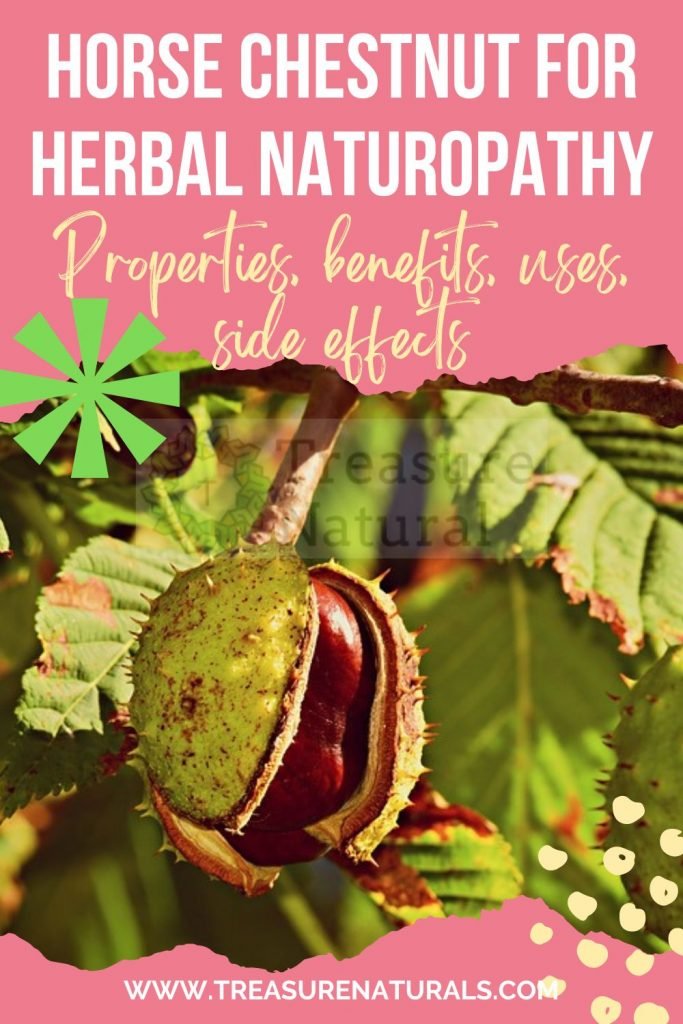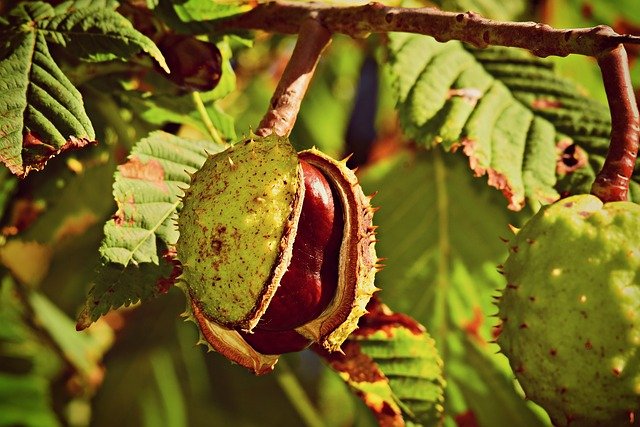
Horse chestnut is a remedy known for its action against water retention, swelling in the legs, cellulite and other disorders related to circulation, including hemorrhoids.
Horse chestnut (Aesculus hippocastanum) is a plant of the Hippocastanaceaceafamily. With a vasoconstrictor and decongestant action, it is useful for the health of blood and lymphatic vessels.
Properties of horse chestnut
Horse chestnut boasts anti-inflammatory and astringent properties and is used for its decongestant, anti-edema and phlebotonic action.
The part of the plant used is the seed. Horse chestnut seeds contain:
- Saponins;
- flavonoids;
- proanthocyanidicne and coumarins responsible for the properties of this natural remedy.
What horse chestnut is used for
Horse chestnut is a plant used in herbal and phytotherapeutic fields in case of:
- Capillary fragility;
- venous insufficiency;
- lymphatic insufficiency;
- oedema;
- cellulitis;
- inflammation of the rectum (proctitis);
- hemorrhoids.
Benefits of horse chestnut
Horse chestnut seeds contain mixture of triterpene saponins known as escin, as well as coumarins (esculetin), flavonoids, proanthocyanidins, starch, and unsaturated fatty acids.
Escin in particular is the most important active ingredient that, together with flavonoids, gives horse chestnut anti-inflammatory, antioxidant and vasoprotective properties, useful in case of problems affecting blood and lymphatic circulation.
In fact, this precious active ingredient is able to reduce the activity of elastase and hyaluronidase, two enzymes that attack the endothelium of the vessels and the extracellular matrix, weakening its structure. By reducing the activity of these enzymes, the vessels regain normal strength and permeability.
Horse chestnut extracts are widely used in the treatment of circulatory disorders in conditions of peripheral venous insufficiency and phlebitis syndromes. Symptoms of chronic venous insufficiency include the appearance of a sense of heaviness, swelling and itching in the legs, often accompanied by night cramps.
Very common is also the use of horse chestnut against hemorrhoids and inflammation of the rectum.
The protective action on the capillaries is expressed in the improvement of the activity of the microcirculation through the reduction of the permeability of the capillaries, thus favoring lymphatic drainage and counteracting capillary fragility, cellulite, swollen and heavy legs.
How to use it
Horse chestnut can be used in the form of a decoction obtained by boiling the bruised seeds or by taking the mother tincture,the bud derivative or the extract. On the market there are also numerous products for external use based on horse chestnut extract, including gels and ointments.
How to use
Decoction
It is prepared with 5-6 grams of bruised seeds for each cup of water.
Mother
tincture 30 drops diluted in water, from one to three times a day.
Bud derivative
50 drops diluted in water, once or twice a day.
Extract
250-300 mg, equal to 50 mg of escin, to be taken for at least one month twice a day.
Where is he
The horse chestnut plant is widespread throughout our country and it is not uncommon to find specimens even in the city, in parks and gardens. Horse chestnut products are easily found in herbal medicine and pharmacies that treat herbal and herbal remedies.
Contraindications of horse chestnut
Horse chestnut remedies are generally well tolerated and side effects can only rarely occur. Among the side effects of horse chestnut we find especially gastrointestinal symptoms such as gastric reflux and nausea. The application of horse chestnut products can instead give itching in sensitive people.
The use of horse chestnut is contraindicated in case of allergy and this remedy should not be used in case of kidney and liver diseases and if antiplatelet and anticoagulants are taken. Use in pregnancy and lactation should be limited and on prescription.
Description of the plant
The horse chestnut tree can reach heights of 25-30 meters; it is therefore an imposing plant with an arboreal bearing. The foliage is expanded, even reaching 8-10 meters in diameter while remaining very compact.
The appearance is roundish or pyramidal, due to the lower branches that have a horizontal trend. The bark is brown and smooth and peels with age.
The leaves of the horse chestnut are deciduous, palmate-compound, with opposite insertion, by means of a petiole of 10-15 cm, on brown or greenish twigs and slightly pubescent; the margin is doubly serrated, the rib is well marked; they are bright green on the upper page and light green, with a slight to mentosity on the ribs, in the lower one.
The flowers of the horse chestnut are collected in raceme inflorescences and have white petals spotted with red, pink in the hybrid pink horse chestnut. The fruit of horse chestnut are fleshy and thorny capsules, which enclose one to three large seeds known as mad chestnut. They have a bitter taste and develop a very unpleasant smell during cooking.
Habitat of horse chestnut
Native to the northern part of the Balkan Peninsula, in Albania, in southern Yugoslavia, in eastern Bulgaria, in northern Greece. Today it is cultivated and widespread in all the temperate zones of Europe, from the plain up to 1200 m. of altitude.
Long-lived and rustic, it tolerates low temperatures and has no particular needs in terms of soil, even if it grows best in fertile soils. It is not very resistant to soil salinity and atmospheric pollutants, to which it reacts with redness of the leaf margins and early desiccation of the foil.
Background

The horse chestnut is an ancient tree, probably a remnant of the Tertiary era. Given the similarity between its fruits and those of the chestnut, the ancients certainly tried to eat the fruits, but soon gave up because the fruits of the horse chestnut, that is, the chestnuts of India, are toxic to man.
In contrast, some wildlife consume the chestnut which is nicknamed “crazy”. On the origin of the name from the Greek hippo means “horse” and kastanon “chestnut” many hypotheses have been made. It is said that horses eat Indian chestnuts, but this is not true, although it is said that the Turks gave the powder derived from Indian chestnuts to horses to heal them from coughing. It was introduced in Vienna in 1591 by Charles de l’Écluse and in Paris, by Bachelier,in 1615 as an ornamental tree.






